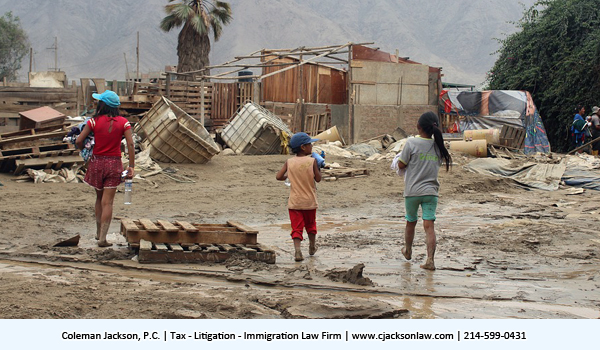By: Coleman Jackson, Attorney, and CPA.
Date: April 01, 2022.
The Department of Homeland Security (DHS) today announced the designation of Afghanistan for Temporary Protected Status (TPS) for 18 months. Only individuals who are already residing in the United States will be eligible for TPS as of March 15, 2022. But what is TPS?
If your home country is a dangerous place, then you may qualify for Temporary Protective Status (TPS) in the United States. In certain unique circumstances, the United States government will grant this special status to immigrants to the United States from certain countries.
If you are currently in the United States and your home country is involved in armed conflict, for example, you may be granted temporary protection status in the United States. The US government may also grant TPS for environmental disasters or severe epidemics – say if there has been an Ebola outbreak or earthquake in your home country.
Read on to find out everything you need to know about Temporary Protected Status (TPS) in the United States and how it works.
How does temporary protection status work?
Temporary Protection Status is available to specific individuals who cannot safely return to their home country. If you are currently visiting the United States or living in the United States, you may qualify for Temporary Protected Status (TPS). TPS may allow you to remain in the United States indefinitely while your home country recovers.
Some of the situations where temporary protected status may be granted include:
- Armed conflicts that are ongoing or have recently occurred
- environmental disasters
- Epidemics or outbreaks
- Other extraordinary and temporary conditions
Few countries receive TPS. After analyzing the situation in a particular country, the Department of Homeland Security (DHS)may choose to grant TPS to a specific country.
If TPS is deemed necessary for a particular country, any citizen of that country in the United States may remain in the United States until the government recovers. Eventually, at some point in the future, DHS will remove TPS from the country as conditions improve. At that point, foreigners will have to return home (or seek a different immigrant visa to stay in the United States). But there are some countries who have been designated TPS for years.
Which countries have temporary protection status?
As of 2022, all of the following countries have Temporary Protected Status according to the United States Department of Homeland Security:
- Burma (Myanmar)
- El Salvador
- Haiti
- Honduras
- Nepal
- Nicaragua
- Somalia
- Sudan
- South Sudan
- Syria
- Venezuela
- Yemen
These countries are on the TPS list for various reasons. Certain countries – including Syria and Yemen – have been plagued by wars in recent years. Other countries – such as Haiti and Nepal – have been severely affected by natural disasters. Some countries have exceptionally high rates of murder and violence.
Note that early this month (March 3, 2022) the Secretary of Homeland Security announced the designation of Ukraine for Temporary Protected Status (TPS) for 18 months and stated the following:
“Russia’s premeditated and unprovoked attack on Ukraine has resulted in an ongoing war, senseless violence, and Ukrainians forced to seek refuge in other countries,” said Secretary Alejandro N. Mayorkas. “In these extraordinary times, we will continue to offer our support and protection to Ukrainian nationals in the United States.”
Further, Secretary Mayorkas designated Afghanistan for TPS on the statutory basis of ongoing armed conflict and extraordinary and temporary conditions that prevent the country’s nationals from returning to safety. The armed conflict that poses a severe threat to the protection of returning residents is ongoing in Afghanistan as the Taliban seeks to impose control in all areas of the country, and Islamic State-Khorasan (IS-K) conducts attacks against civilians. Extraordinary and temporary conditions that further prevent nationals from returning in safety include a collapsing public sector, a worsening economic crisis, drought, food and water insecurity, lack of access to healthcare, internal displacement, human rights abuses, repression by the Taliban, destruction of infrastructure, and increasing crime.
Temporary protection status requirements
To qualify for Temporary Protection Status, you must meet several requirements, including:
- You must be a national of a country on the TPS list or a person without nationality who has previously lived in a TPS country
- You must apply for TPS during the registration or re-registration period or be eligible for late application.
- You must have already been in the United States when your country was added to the TPS list
- You must live continuously in the United States from the time your country received TPS status until the time you applied for a visa; When you apply or re-register for TPS, you must inform USCIS of all absences from the United States, although the law allows an exception for “short, casual, and innocent departures from the United States.”
Specific individuals may be ineligible for TPS status even if they meet the above requirements or qualify for TPS. You may be ineligible if:
- You are convicted of a felony or more than two misdemeanors in the United States
- You are inadmissible to the United States due to security concerns, including criminal and security reasons.
- You are subject to any mandatory asylum ban, including participation in the persecution of another individual or involvement in or incitement to terrorist activities.
- You were unable to meet continued physical presence and continued residency in the United States requirements; say, if you left the United States after your country received TPS, but before you applied for TPS yourself
- You have not re-registered for TPS as needed without causing
How to apply for temporary protection status (TPS)
Applying for Temporary Protected Status (TPS) requires you to submit supporting documents and other evidence to the USCIS. Your documents must prove that you meet the requirements listed above.
This is the general process for applying for Temporary Protected Status (TPS) with USCIS:
Step 1) Submit the temporary protection status form
TPS applicants must file a unique form called Form I-821, Application for Temporary Protection Condition. Some applicants also choose to attach Form I-765, Application for Employment Authorization, which allows you to begin work immediately if your citizenship is approved. Forms and all applicable documents must be submitted to USCIS.
If you believe you may be inadmissible to the United States (say, if you have a criminal record or other reasons to be denied), you may also file Form I-601, Request for Waiver of Justification Inadmissibility.
Step 2) Attach supporting documents
You will need to attach supporting documents to your application, including documents proving that you are a resident of a country on the TPS list.
Proof of identity and nationality
First, you will need to prove that you are a national of a TPS-designated country. You can do this by sending:
- A copy of your TPS list country passport
- A copy of your birth certificate with a photo identifying you
- A copy of a national identity document with a photo or fingerprint issued by an embassy or consulate of your country in the United States
Other evidence that proves your identity and nationality may include:
- Documents proving your nationality, including a certificate of naturalization that does not necessarily need to have a photo or fingerprint
- A baptism certificate proving your nationality or the nationality of your parents
- Copies of school records or medical records from a TPS list country
- Copies of immigration documents proving your identity or nationality
- Testimonials from friends or family proving your identity or nationality, including statements confirming your place and date of birth
Entry date proof
The United States also needs to verify that you have entered the United States before your country has been added to the TPS list. To prove this, you can provide:
- A copy of your passport
- Form I-94, United States Arrival/Departure Record
- Copies of documents from your stay in the United States, including lease agreements, receipts, employment contracts, and other evidence
Proof of continuous residency
Finally, to qualify for the TPS, you must prove that you have been in the United States continuously since your country was added to the TPS list. You cannot travel back to your home country after it has been added to the TPS list and then return to the United States in pursuit of Temporary Protected Status. To prove continuous residency, you may need to provide the following documents:
- Rental agreement or receipts, including utility bills, hotel receipts, or other evidence
- employment records
- School Letters, including proof of admission and studies at a US school
- Medical or hospital records proving that you or a family member received treatment in the United States
- Testimonials from an organization – such as a church – that confirms that you have been in the United States continuously for a certain period of time
Step 3) Submit the Application
Once you have collected all of the above evidence, you can submit the petition to USCIS. If USCIS accepts your petition, you will receive an acknowledgment of receipt. If your petition is rejected, USCIS will list the reasons for the rejection and explain whether or not you can re-apply. It usually takes around three weeks to process the application.
Step 4) Biometric Collection
USCIS may require additional documents after receiving your TPS application, including biometric details such as fingerprints and photographs. If the USCIS requires this information, they will send you a notice. Generally, any TPS candidate over age 14 will need to provide biometric data such as photographs, fingerprints, or signatures.
USCIS will ask TPS applicants to look for an Application Support Center (ASC), where your biometrics will be used to verify your identity, confirm your country of residence, and complete a background check. Your EAD may also be issued in an ASC.
You may need to bring all of the following documents to your ASC interview, including:
- A document that proves your identity
- A photograph that complies with US visa photo requirements
- USCIS ASC Nomination Confirmation Notification
- Employment Authorization Document (EAD)if you don’t have one yet
You may also request to reschedule the appointment if you cannot meet the schedule stated in your USCIS letter.
Step 5) Wait for a decision from the USCIS
Eventually, USCIS will decide on your application for Temporary Protected Status, choosing to approve or deny your application. Your EAD will also be approved or denied (if you applied for an EAD).
How long does my TPS last?
Depending on the situation in your country, your individual TPS will be valid for no less than six months and no more than 18 months.
After the TPS period, you can re-register or extend your TPS.
Can I leave the United States while I am under TPS?
If you have temporary protection status, you will need a travel authorization document to leave the United States – even temporarily and briefly. You can apply for travel authorization by completing Form I-131, Application for a Travel Document, and submitting it to USCIS.
Finally, Temporary Protected Status is a unique type of status extended to citizens of certain countries experiencing temporary disasters, wars, or other dangerous situations. If you are in the United States while your country is added to the TPS list, you may qualify for Temporary Protected Status.
This law blog is written by the Taxation | Litigation | Immigration Law Firm of Coleman Jackson, P.C. for educational purposes; it does not create an attorney-client relationship between this law firm and its reader. You should consult with legal counsel in your geographical area with respect to any legal issues impacting you, your family or business.
Coleman Jackson, P.C. | Taxation, Litigation, Immigration Law Firm | English (214) 599-0431 | Spanish (214) 599-0432 | Portuguese (214) 272-3100



